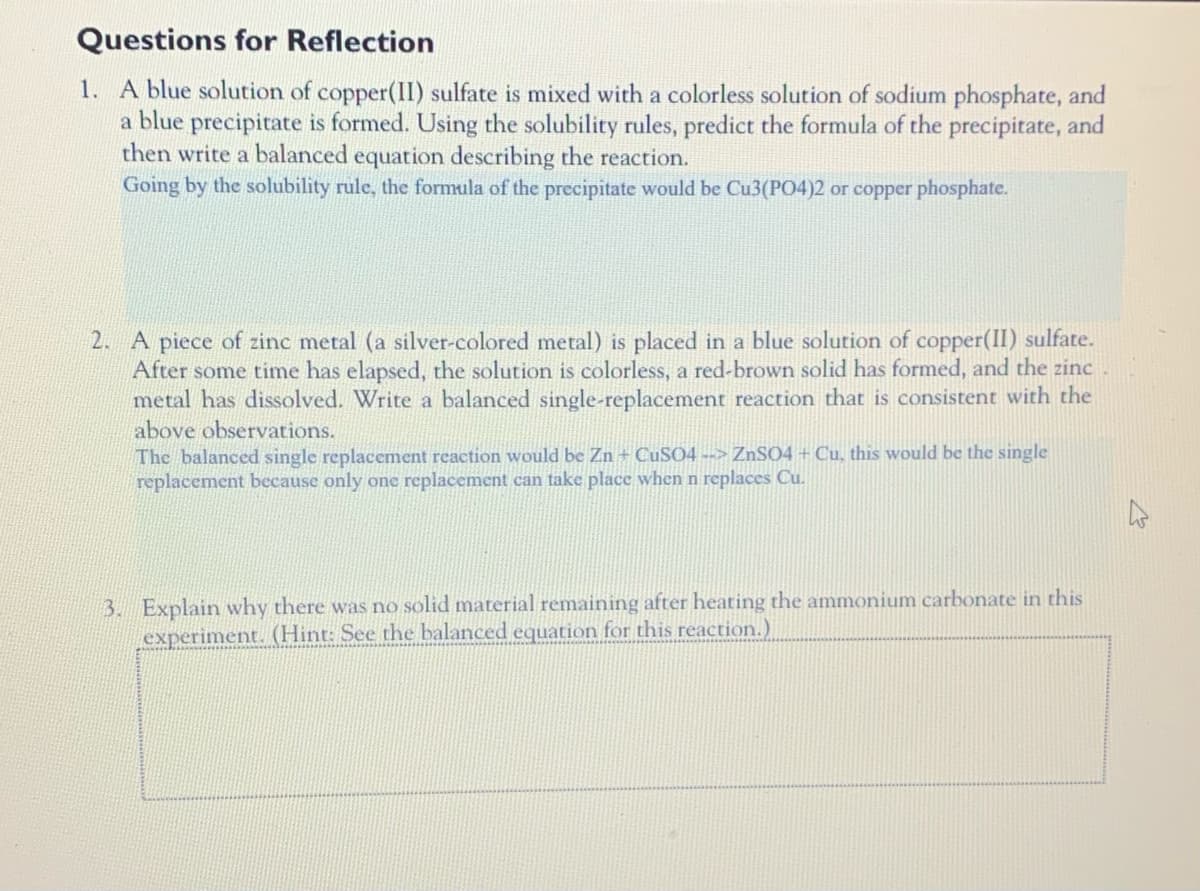Explain why there was no solid material remaining after heating the ammonium carbonate in this experiment. (Information for this report is within the photo)
Explain why there was no solid material remaining after heating the ammonium carbonate in this experiment. (Information for this report is within the photo)
Introductory Chemistry: A Foundation
9th Edition
ISBN:9781337399425
Author:Steven S. Zumdahl, Donald J. DeCoste
Publisher:Steven S. Zumdahl, Donald J. DeCoste
Chapter15: Solutions
Section: Chapter Questions
Problem 42CR: 42. a. Fill in the following table as if it is a well plate and you are mixing two aqueous compounds...
Related questions
Question
Explain why there was no solid material remaining after heating the ammonium carbonate in this experiment. (Information for this report is within the photo)

Transcribed Image Text:Questions for Reflection
1. A blue solution of copper(II) sulfate is mixed with a colorless solution of sodium phosphate, and
a blue precipitate is formed. Using the solubility rules, predict the formula of the precipitate, and
then write a balanced equation describing the reaction.
Going by the solubility rule, the formula of the precipitate would be Cu3(PO4)2 or copper phosphate.
2. A piece of zinc metal (a silver-colored metal) is placed in a blue solution of copper(II) sulfate.
After some time has elapsed, the solution is colorless, a red-brown solid has formed, and the zinc
metal has dissolved. Write a balanced single-replacement reaction that is consistent with the
above observations.
The balanced single replacement reaction would be Zn + CUSO4 --> ZnSO4 + Cu, this would be the single
replacement because only one replacement can take place when n replaces Cu.
3. Explain why there was no solid material remaining after heating the ammonium carbonate in this
experiment. (Hint: See the balanced equation for this reaction.)
Expert Solution
This question has been solved!
Explore an expertly crafted, step-by-step solution for a thorough understanding of key concepts.
This is a popular solution!
Trending now
This is a popular solution!
Step by step
Solved in 2 steps

Knowledge Booster
Learn more about
Need a deep-dive on the concept behind this application? Look no further. Learn more about this topic, chemistry and related others by exploring similar questions and additional content below.Recommended textbooks for you

Introductory Chemistry: A Foundation
Chemistry
ISBN:
9781337399425
Author:
Steven S. Zumdahl, Donald J. DeCoste
Publisher:
Cengage Learning

Introductory Chemistry: A Foundation
Chemistry
ISBN:
9781285199030
Author:
Steven S. Zumdahl, Donald J. DeCoste
Publisher:
Cengage Learning

Chemistry
Chemistry
ISBN:
9781305957404
Author:
Steven S. Zumdahl, Susan A. Zumdahl, Donald J. DeCoste
Publisher:
Cengage Learning

Introductory Chemistry: A Foundation
Chemistry
ISBN:
9781337399425
Author:
Steven S. Zumdahl, Donald J. DeCoste
Publisher:
Cengage Learning

Introductory Chemistry: A Foundation
Chemistry
ISBN:
9781285199030
Author:
Steven S. Zumdahl, Donald J. DeCoste
Publisher:
Cengage Learning

Chemistry
Chemistry
ISBN:
9781305957404
Author:
Steven S. Zumdahl, Susan A. Zumdahl, Donald J. DeCoste
Publisher:
Cengage Learning

Chemistry: An Atoms First Approach
Chemistry
ISBN:
9781305079243
Author:
Steven S. Zumdahl, Susan A. Zumdahl
Publisher:
Cengage Learning


General Chemistry - Standalone book (MindTap Cour…
Chemistry
ISBN:
9781305580343
Author:
Steven D. Gammon, Ebbing, Darrell Ebbing, Steven D., Darrell; Gammon, Darrell Ebbing; Steven D. Gammon, Darrell D.; Gammon, Ebbing; Steven D. Gammon; Darrell
Publisher:
Cengage Learning